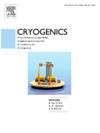Experimental study of cryogenic flow quenching of stainless steel tubes with thickness-gradient Teflon coatings
IF 2.1
3区 工程技术
Q3 PHYSICS, APPLIED
引用次数: 0
Abstract
Applying a low thermal conductivity coating layer to the inner wall of the tubes is a promising approach to accelerating the chilldown process, with extensive research focusing on the impact of coating thickness on the chilldown performance. It was concluded that there exists an optimal thickness of the coating layer for shortening chilldown time. However, the optimal thickness is apparently not uniform along the axis of tube due to the variation of heat transfer characteristics at different axial positions. Therefore, the chilldown behavior of tubes with uniform coating thicknesses ranging from 24 µm to 201 µm and the tube with thickness-gradient coating layer of approximately 146 µm to 71 µm along the axial direction are investigated by conducting horizontal flow quenching experiments using liquid nitrogen at different inlet pressures. It is found that, when liquid nitrogen flows from the thick coating layer (146 µm) side to the thin coating layer (71 µm) side, the chilldown time is reduced by 12.1–16.3% compared to the opposite flow direction, and by 7.1% compared to the uniform-coated tube with similar average thickness. It can be concluded that the thicker coating layer upstream allows earlier emergence of transition boiling, thereby accelerating the film boiling process downstream. The Leidenfrost point temperature upstream is higher than that downstream due to the increased solid-liquid contacts. Additionally, the pressure drop measurement throughout the tube reveals that the onset of the transition boiling intensifies flow turbulence, and consequently enhances heat transfer of film boiling downstream.
厚度梯度聚四氟乙烯涂层不锈钢管低温流淬实验研究
在管道内壁涂覆低导热系数的涂层是一种很有前途的加速冷却过程的方法,广泛的研究集中在涂层厚度对冷却性能的影响上。结果表明,存在缩短冷却时间的最佳涂层厚度。然而,由于不同轴向位置的换热特性不同,最佳厚度沿管轴线方向明显不均匀。因此,采用液氮在不同进口压力下进行水平流动淬火实验,研究了沿轴向均匀涂层厚度为24µm ~ 201µm和厚度梯度涂层厚度约为146µm ~ 71µm的钢管的冷却行为。研究发现,当液氮从厚涂层(146µm)侧流向薄涂层(71µm)侧时,冷却时间比反方向减少12.1 ~ 16.3%,比平均厚度相近的均匀涂层管减少7.1%。可以得出结论,上游较厚的涂层层可以更早地出现过渡沸腾,从而加速下游的膜沸腾过程。由于固液接触增加,上游的莱顿弗罗斯特点温度高于下游的莱顿弗罗斯特点温度。此外,整个管内的压降测量表明,过渡沸腾的开始加剧了流动湍流,从而增强了下游膜沸腾的传热。
本文章由计算机程序翻译,如有差异,请以英文原文为准。
求助全文
约1分钟内获得全文
求助全文
来源期刊

Cryogenics
物理-热力学
CiteScore
3.80
自引率
9.50%
发文量
0
审稿时长
2.1 months
期刊介绍:
Cryogenics is the world''s leading journal focusing on all aspects of cryoengineering and cryogenics. Papers published in Cryogenics cover a wide variety of subjects in low temperature engineering and research. Among the areas covered are:
- Applications of superconductivity: magnets, electronics, devices
- Superconductors and their properties
- Properties of materials: metals, alloys, composites, polymers, insulations
- New applications of cryogenic technology to processes, devices, machinery
- Refrigeration and liquefaction technology
- Thermodynamics
- Fluid properties and fluid mechanics
- Heat transfer
- Thermometry and measurement science
- Cryogenics in medicine
- Cryoelectronics
 求助内容:
求助内容: 应助结果提醒方式:
应助结果提醒方式:


